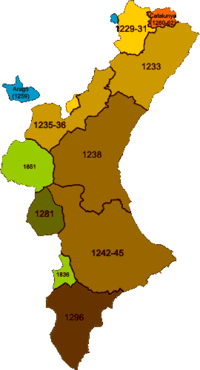
The Reconquista or the reconquest of al-Andalus was a series of military and cultural campaigns that European Christian kingdoms waged against the Muslim kingdoms following the Muslim conquest of the Iberian Peninsula by the Umayyad Caliphate, culminating in the reign of the Catholic Monarchs of Spain. The beginning of the Reconquista is traditionally dated to the Battle of Covadonga, in which an Asturian army achieved the first Christian victory over the forces of the Umayyad Caliphate since the beginning of the military invasion. The Reconquista ended in 1492 with the fall of the Nasrid kingdom of Granada to the Catholic Monarchs.
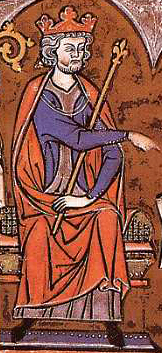
James I the Conqueror was King of Aragon, Count of Barcelona, and Lord of Montpellier from 1213 to 1276; King of Majorca from 1231 to 1276; and King of Valencia from 1238 to 1276. His long reign of 62 years is not only the longest of any Iberian monarch, but one of the longest monarchical reigns in history, ahead of Hirohito but remaining behind Queen Elizabeth II, Queen Victoria, and Ferdinand III of Naples and Sicily.

The Crown of Aragon was a composite monarchy ruled by one king, originated by the dynastic union of the Kingdom of Aragon and the County of Barcelona and ended as a consequence of the War of the Spanish Succession. At the height of its power in the 14th and 15th centuries, the Crown of Aragon was a thalassocracy controlling a large portion of present-day eastern Spain, parts of what is now southern France, and a Mediterranean empire which included the Balearic Islands, Sicily, Corsica, Sardinia, Malta, Southern Italy, and parts of Greece.
This is a timeline of notable events during the period of Muslim presence in Iberia, starting with the Umayyad conquest in the 8th century.

The Kingdom of Valencia, located in the eastern shore of the Iberian Peninsula, was one of the component realms of the Crown of Aragon.

Zayd Abu Zayd was the last Almohad governor of Valencia.
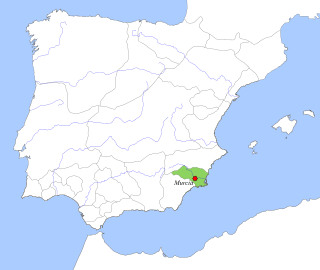
The Taifa of Murcia was an Arab taifa of medieval Al-Andalus, in what is now southern Spain. It became independent as a taifa centered on the Moorish city of Murcia after the fall of the Umayyad Caliphate of Córdoba. The Moorish Taifa of Murcia included Albacete and part of Almería as well.

Valencians are the native people of the Valencian Community, in eastern Spain. Legally, Valencians are the Spanish inhabitants of the community. Since 2006, the Valencian people are officially recognised in the Valencian Statute of Autonomy as a nationality "within the unity of the Spanish nation". The official languages of Valencia are Valencian and Spanish.

The siege of al-Dāmūs was a battle of the Reconquista that occurred in the year 1210. The forces of the Kingdom of Aragon, together with auxiliary forces of the Knights Templar and Knights Hospitaller, were pitted against the defending forces of the Almohades. The Christian forces defeated the Muslim defenders. This battle was significant because in taking the castle at Ademuz, the Christian forces riled their Muslim opponents to initiate a grand offensive that would eventually culminate in the Battle of Las Navas de Tolosa. This offensive, in turn, marked the end of the Islamic domination of the region and the beginning of Christian rule in the province.
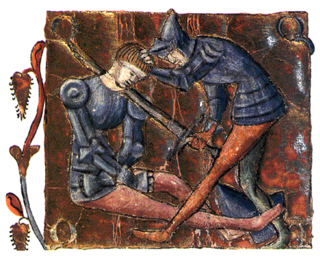
The Battle of Bairén was fought between the forces of Rodrigo Díaz de Vivar, also known as "El Cid", in coalition with Peter I of Aragon, against the forces of the Almoravid dynasty, under the command of Muhammad ibn Tasufin. The battle was part of the long Reconquista of Spain, and resulted in a victory for the forces of the Kingdom of Aragon and the Principality of Valencia.

The Battle of the Puig of 1237, also known as the Battle of the Puig de Santa Maria, the Battle of the Puig de Enesa, or the Battle of the Puig de Cepolla was a battle of the Iberian Reconquista and of the Aragonese Conquest of Valencia.
Zayyan ibn Mardanish or Zayán Ibn Mardanix also known as Zahén or Çaèn, was the last king of the Taifa of Valencia before it fell to the Kingdom of Aragon in the Reconquista campaign led by James I of Aragon.

The Battle of Fraga was a battle of the Spanish Reconquista that took place on 17 July 1134 at Fraga, Aragon, Spain. The battle was fought between the combined forces of King Alfonso I of Aragon and Viscount Centule VI of Béarn, and a variety of Almoravid forces that had come to the aid of the town of Fraga which was being besieged by King Alfonso I. The battle resulted in an Almoravid victory. The Aragonese monarch Alfonso I died shortly after the battle.

The siege of Algeciras was a battle of the Spanish Reconquista that occurred between July 1309 and January 1310. The battle was fought between the forces of the Kingdom of Castile, commanded by King Ferdinand IV of Castile and his vassals, and the Emirate of Granada commanded by Sultan Abu'l-Juyush Nasr. The battle resulted in a humiliating defeat for the Kingdom of Castile whose army was obliged to lift the siege due to the atrocious conditions of life in the Castilian camp and the desertion of Infante John of Castile. The battle marked one of the many battles fought at Algeciras where the Christian forces would try to take the city unsuccessfully from the Muslims.
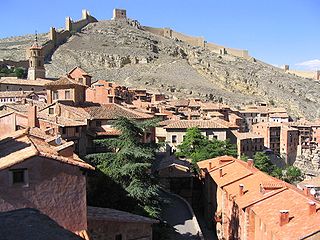
The siege of Albarracín was a battle fought during the reign of Peter III of Aragon, King of Aragón from the months of April to September 1284. Albarracín, which had for some time belonged to Juan Núñez I de Lara, the head of the House of Lara, was besieged by an Aragonese force. The siege resulted in the successful taking of the city by Aragonese forces after which, Peter III handed gifted the city to his illegitimate son, Ferdinand of Aragón.

The conquest of the island of Majorca on behalf of the Roman Catholic kingdoms was carried out by King James I of Aragon between 1229 and 1231. The pact to carry out the invasion, concluded between James I and the ecclesiastical and secular leaders, was ratified in Tarragona on 28 August 1229. It was open and promised conditions of parity for all who wished to participate.

The Lordship of Albarracín was an independent Christian lordship in the Kingdom of Aragón located in and around the city of Albarracín. Its location was a buffer wedged between the Kingdom of Aragón and the Kingdom of Castile. The Señorío was created after the partition of the Taifa of Albarracín belonging to the Berber line of Banu Razín.

The Carabona Tower, also called the Farmhouse of Carabona, is a cultural heritage site in the municipality of Burriana, close to the “Camí del Palmeral” road and about 250 meters away from “Camí Vell de Valencia” road, in the region of Plana Baixa in the province of Castellón, Spain. According to the General Directory of Artistic Heritage of the Generalitat Valenciana, it received its ministerial annotation number (R-I-51-0010939) on December 4, 2002.
The siege of Almería was an unsuccessful attempt by Aragon to capture the city of Almería from the Emirate of Granada in 1309. Almería, a Mediterranean port in the southeast of the emirate, was the initial Aragonese target in a joint Aragonese-Castilian campaign aimed at conquering Granada. The Aragonese troops led by their King James II arrived on 11 August, blockading the city and employing siege engines. The city, led by governor Abu Maydan Shuayb and naval commander Abu al-Hasan al-Randahi, prepared for the siege by strengthening its defenses and stockpiling food. Throughout the siege, both sides exchanged shots from siege engines and engaged in fields battles and skirmishes with varying results. James ordered multiple unsuccessful assaults. A Granadan relief column under Uthman ibn Abi al-Ula arrived nearby in September and harassed the besiegers.

The conquest of Valencia by the Catalan and Aragonese troops of King James I of Aragon took place on 9 October 1238.
